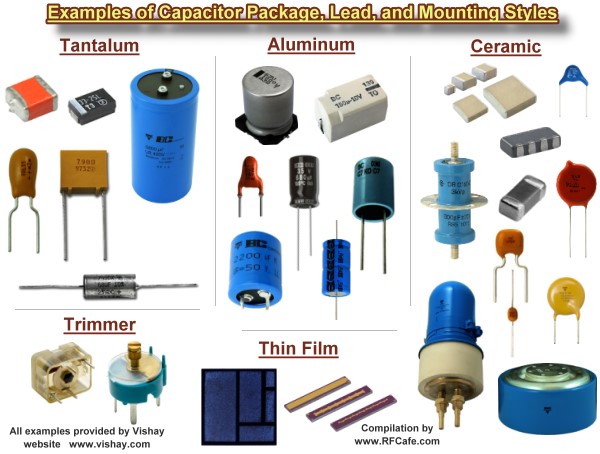Capacitors are passive electronic components that store electrical energy in an electric field. They are among the most ubiquitous and important elements in electronic circuit design and implementation. This in-depth guide will explore what capacitors are, how they work, their key properties, types of capacitors, and their diverse range of applications in all manner of electric and electronic circuits.
What is a Capacitor?
A capacitor is a two-terminal electronic component capable of storing energy in the form of an electrostatic field. It essentially consists of two conductive plates separated by an insulating dielectric material. When voltage is applied across the plates, electrons accumulate on one plate, while positively charged ions accumulate on the opposite plate. The capacitor “charges up”, storing energy in the polarized molecules of the dielectric material.
Benjamin Franklin first experimented with capacitors in the 18th century by stacking metal foil between sheets of glass. Today, capacitors come in an enormous variety of shapes, sizes and types to suit different applications. But they all work on the same essential principle of storing charge across the gap between two conductors.
How Do Capacitors Work?
When voltage is first applied across an uncharged capacitor’s plates, current flows as the electric field is established and charge accumulates on the plates. As the plates reach full charge capacity, current flow decreases and eventually drops to zero while the voltage remains constant. The capacitor now contains the maximum energy it can store at that voltage, which equals 1/2CV2 (C = capacitance, V = voltage).
This charging process happens extremely quickly, often in nanoseconds or less. When the capacitor is disconnected from the charging circuit, the voltage remains stored indefinitely across the dielectric – the capacitor acts like a small rechargeable battery. Discharging a capacitor is similarly fast when it is reconnected to a conductive path. The stored energy is released as current flows back out of the capacitor.
Capacitors block direct current (DC) while allowing alternating current (AC) to pass – at least for a short time while the capacitor charges and discharges. This property makes capacitors highly useful in filtering applications for power supplies and audio equipment. Combined with resistors, they can form RC timing circuits critical for oscillators and timers.
Key Capacitor Properties
There are several key properties that define the characteristics and performance of a capacitor:
Capacitance: Measured in farads, this is the capacitors ability to store an electrical charge. Higher capacitance means more charge can be stored.
Voltage Rating: The maximum DC or AC voltage that can be applied without damaging the dielectric.
Leakage Current: A small current that flows when the capacitor is disconnected, due to imperfect insulation. Lower is better.
Equivalent Series Resistance (ESR): The inherent internal resistance in the capacitor plates and terminals, which causes power loss. Lower ESR improves efficiency.
Dielectric Strength: The maximum electric field strength the dielectric can withstand without breakdown and short circuit.
Temperature Rating: The range of temperatures a capacitor can safely operate within.
Types of Capacitors
There is an extensive variety of capacitors available to suit different applications:
Ceramic Capacitors: Tiny, inexpensive, low capacitance. Used for bypassing, coupling and filtering.
Electrolytic Capacitors: High capacitance and compact size but polar. Often used for power supply filtering.
Tantalum Capacitors: More stable than electrolytic but also polar. Used in sample and hold circuits.
Film Capacitors: Very low leakage current makes them well-suited to timing and tuning circuits.
Supercapacitors: Extremely high capacitance but low voltage rating. Used to store renewable energy.
Variable Capacitors: Capacitance can be tuned over a range via moving plates. Used in radio tuning.
Digital Variable Capacitors: Capacitance digitally controlled by an applied voltage. Used in phase-locked loops.
This list barely scratches the surface of the vast capacitor menu available to circuit designers today. The specific application ultimately determines the ideal type of capacitor to use.
Capacitor Applications in Circuits
The unique properties of capacitors make them invaluable in an enormous variety of circuits and applications. A few examples include:
Decoupling and Bypassing: Suppressing power supply noise by placing ceramic capacitors close to IC power pins. The capacitors provide localized charge reservoirs to handle current spikes.
As Columbia University professor David Vallancourt explains:
“Capacitors help provide stable voltage rails for sensitive logic elements. Any IC worth its salt has decoupling capacitors all over the place.”
Timing Circuits: RC oscillators and timers use the timing of capacitor charging and discharging cycles to generate precision clock signals. Heart pacemakers rely on such timing circuits.
Tuning Circuits: Variable capacitors allow tuning over a band of frequencies in radio receivers and transmitters. They enabled the first tunable commercial radios.
Snubber Circuits: Capacitors suppress voltage spikes in inductive circuits and from switches, protecting components from high transient voltages.
Power conditioning: Large capacitor banks smooth rectified AC into steady DC for power supplies. They also store energy for burst needs.
Signal coupling: Passing AC signals between circuits while blocking DC offsets. The music signals in guitar effect pedals use series capacitors to eliminate battery DC voltage.
Filters: Combining inductors and capacitors creates adjustable filter circuits for targeting specific frequencies. HiFi EQs and radios depend on such active filters.
The list of applications only continues to grow as engineers find new ways to exploit the unique properties of these versatile components.
Selecting the Right Capacitor
With such a broad array of capacitor characteristics and types, it can be challenging to select the optimal capacitor for a given application. Here are some key considerations when choosing a capacitor:
-
Determine the required capacitance value from circuit equations or experiments. Allow margin for aging and temperature effects.
-
Check that the capacitor’s voltage rating exceeds the working voltages and transients experienced.
-
For power circuits, choose low ESR capacitors to maximize efficiency and lifespan, e.g. tantalum or polymer electrolytic.
-
For high frequency circuits, select film or ceramic capacitors for their superior high frequency performance.
-
Match the capacitor’s temperature range to the climate it will operate in, from freezing cold to hot sun.
-
Consider physical size limitations and mounting options. Radial versus axial leads or surface mount.
By carefully evaluating these factors, you can ensure an effective, reliable, and safe capacitor choice for your specific application needs.
Conclusion
From their origins in Leyden jars centuries ago, capacitors have become one of the most widespread fundamental components found in all types of circuits and electronic devices. Their unique ability to dynamically store and release electrical charge makes them indispensable for applications ranging from timing and tuning to power conditioning and signal coupling. As technology progresses, engineers continue finding new ways to exploit capacitors to improve circuit performance and enable new devices. The wide range of available capacitor types and properties allows matching the perfect capacitor to its intended purpose. With a grasp of their operating principles and key characteristics, engineers can confidently select the optimal capacitors to solve the challenges of their unique circuit designs.















